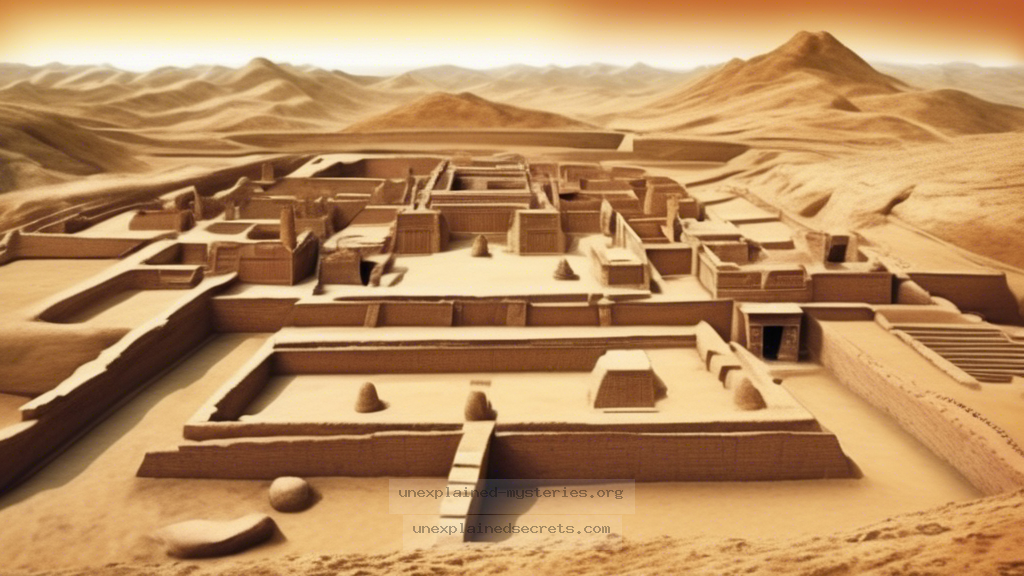What Happened to the Advanced Civilization of the Indus Valley, and Why Did It Disappear?
What Happened to the Advanced Civilization of the Indus Valley, and Why Did It Disappear?
The mystery of ancient civilizations often captivates our imagination, and few are as enigmatic as the Indus Valley Civilization. Once a flourishing society that thrived between 2600 BCE and 1900 BCE, the Indus Valley Civilization is a testament to advanced urban planning, sophisticated drainage systems, and a writing system that remains undeciphered. But what led to its sudden decline? Understanding this question not only sheds light on one of humanity’s earliest urban cultures but also provides insights into the resilience and vulnerability of civilizations as a whole. 💡
Historical Context of the Indus Valley Civilization
The Indus Valley Civilization, also known as the Harappan Civilization, covered a vast area in present-day Pakistan and northwest India. It included major urban centers like Harappa and Mohenjo-Daro, known for their remarkable grid layout, multi-story houses, and advanced public sanitation systems. The civilization traded extensively with neighboring cultures, including Mesopotamia, and showcased an impressive level of craftsmanship in pottery, jewelry, and seal-making.
Urban centers like Mohenjo-Daro featured a sophisticated drainage system that is still regarded as one of the most advanced of its time. The layout of cities indicated a central planning authority, suggesting a complex social structure. Yet, despite this impressive legacy, the civilization experienced a decline around 1900 BCE, leaving modern archaeologists puzzled. What could have caused such a dramatic fall? ⚠️
Core Theories Explaining the Decline
Several theories have emerged to explain the disappearance of the Indus Valley Civilization. Each theory offers a different perspective on the possible factors that could have contributed to the civilization’s decline.
- Climate Change: One of the leading theories posits that significant climatic shifts led to reduced rainfall, which in turn caused drought conditions. This would have severely impacted agriculture, which was the backbone of the Indus economy.
- River Shifts: The civilization was closely tied to the Indus River for irrigation and trade. Geological studies indicate that the river may have changed course, leading to flooding or desertification of crucial agricultural land.
- Invasion or Migration: Some historians suggest that invasions by nomadic tribes from the north could have led to the civilization’s downfall. However, archaeological evidence supporting widespread violence is scant.
- Sociopolitical Factors: Internal strife, social upheaval, or the inability to manage resources could have led to the collapse of this complex society.
Evidence of Climate Change
Archaeological evidence suggests that the Indus Valley experienced significant climate change during its decline. Studies of sediment cores from the Arabian Sea reveal that the region underwent a period of aridification around the time of the civilization’s decline. This change would have drastically reduced agricultural yields, leading to food shortages and social unrest.
The implications of climate change extend beyond mere agriculture; it can transform entire societies, leading to migration or collapse. In the case of the Indus Valley, the evidence indicates a gradual decline in urban activity, suggesting that the inhabitants may have migrated to more fertile areas as their agricultural lands dried up. ✅
Geological Evidence and River Dynamics
Geological surveys and satellite imagery have provided insight into the changing courses of rivers in the region. Research indicates that the Indus River, which was once a reliable source of water, may have shifted significantly due to tectonic activity or sedimentation. Such changes would have disrupted irrigation systems and affected trade routes.
Additionally, the presence of ancient riverbeds and flood deposits indicates that the region experienced alternating phases of flooding and drought. This instability would have made it increasingly difficult for the civilization to sustain itself, leading to a gradual decline in urban centers. The Harappans might have adapted by relocating to areas with more reliable water sources, leading to the fragmentation of the civilization. 🌊
Archaeological Findings and Their Implications
Archaeological excavations in the Indus Valley have unearthed a wealth of artifacts, including seals, pottery, and tools. However, one of the most intriguing aspects of the archaeological record is the sudden abandonment of many urban sites. Excavations show that many buildings were left intact but devoid of inhabitants, indicating a rapid decline rather than a slow decay.
For example, in Mohenjo-Daro, evidence suggests that the population may have decreased significantly around 1900 BCE, as indicated by the lack of new constructions and the deterioration of public buildings. This abrupt change supports theories of environmental stress or societal upheaval, as opposed to a gradual decline due to resource depletion. The archaeological record thus compels us to consider the possibility of a complex interplay of factors contributing to this ancient mystery. 🏺
Comparative Analysis: The Collapse of Other Civilizations
To better understand the decline of the Indus Valley Civilization, it can be useful to compare it with other ancient cultures that faced similar challenges. For instance, the Maya Civilization also experienced a significant decline due to climate change, resource depletion, and social conflict. The decline of the Roman Empire offers another perspective, as it faced internal strife, invasions, and economic challenges.
| Civilization | Factors of Decline | Lessons Learned |
|---|---|---|
| Indus Valley | Climate change, river shifts, sociopolitical factors | The importance of sustainable resource management |
| Maya | Drought, warfare, societal collapse | Environmental sustainability is crucial for survival |
| Roman Empire | Political corruption, economic instability, invasions | Strong governance and adaptability are essential |
Alternative Perspectives: The Role of Culture and Society
While environmental factors are often highlighted in discussions about the decline of civilizations, cultural and societal elements also play a significant role. The Indus Valley Civilization was known for its social complexity, which included trade networks, religious practices, and possibly a form of governance. Changes in cultural practices or shifts in trade dynamics could have contributed to societal fragmentation.
For instance, the introduction of new trade routes or technologies might have altered the economic landscape, leading to shifts in power and influence among cities. This could have resulted in internal conflicts or changes in leadership that further destabilized the society. Understanding these cultural dynamics is essential for a holistic view of the civilization’s decline. 🔍
Common Misconceptions and Clarifications
There are several misconceptions about the Indus Valley Civilization that can cloud our understanding of its decline:
- Monolithic Culture: It’s a common belief that the Indus Valley was a homogenous culture. In reality, it likely consisted of diverse communities with varying practices and beliefs.
- Sudden Collapse: While the civilization experienced a decline, it is essential to recognize that this was likely a gradual process influenced by multiple factors rather than a sudden collapse.
- Complete Disappearance: Some believe that the people of the Indus Valley vanished entirely. However, evidence suggests that descendants may have integrated into surrounding cultures, continuing their legacy in different forms.
Best Practices for Investigation and Study
For researchers and enthusiasts interested in studying the Indus Valley Civilization and its decline, several best practices can enhance their understanding:
- Interdisciplinary Approach: Combining archaeology, climatology, and anthropology can yield richer insights.
- Field Research: Engaging in field studies and excavations can provide firsthand experience and data.
- Public Engagement: Sharing findings with the public can lead to greater interest and support for archaeological endeavors.
Future Developments: Ongoing Research and New Technologies
The study of the Indus Valley Civilization is far from over. Ongoing research is utilizing advanced technologies, such as satellite imaging and ground-penetrating radar, to uncover new sites and artifacts. These technologies can reveal hidden structures and provide insights into urban planning and societal organization.
Moreover, interdisciplinary collaborations are increasingly common, allowing researchers to analyze ancient DNA, study ancient agricultural practices, and even model climate scenarios to understand the factors that led to the civilization’s decline. As new discoveries are made, our understanding of this ancient culture continues to evolve. 🌍
Conclusion
The mystery surrounding the decline of the Indus Valley Civilization is a complex tapestry woven from environmental, cultural, and societal threads. While climate change and geological shifts are crucial factors, the interplay of societal dynamics cannot be overlooked. By comparing the Indus Valley with other ancient civilizations, we gain valuable insights into the forces that shape human societies and their legacies.
As research continues and new technologies emerge, we may yet uncover further secrets of this remarkable civilization, deepening our understanding of its rise and fall. The lessons learned from the Indus Valley are not only relevant to historians and archaeologists but also resonate with contemporary societies grappling with issues of sustainability and resilience. In exploring the past, we may find guidance for navigating the complexities of the present and future. ✅
Other Articles
Recent Posts
- What Happened to Flight MH370? The Conspiracy Theories That Still Haunt Us
- What Secrets Lurk Within the Walls of the Infamous Trans-Allegheny Lunatic Asylum?
- What Evidence Supports the Existence of Bigfoot in the Pacific Northwest?
- What Happened to the Indus Valley Civilization? Unraveling the Mysteries of Ancient Urban Life
- Can Telepathy Be Scientifically Proven Through Laboratory Evidence?







